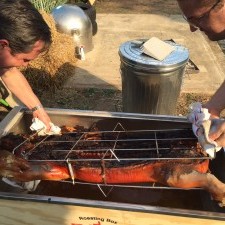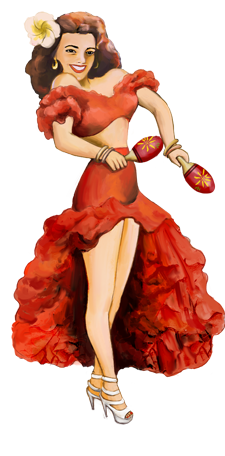

For Cubans, “puerco asao” (roasted pork) is one of their most entrenched and ancient traditions. It is synonymous of party, joy, family reunion, beer and rum. It is a ritual that brings together close family members, neighbors, friends, and even strangers on occasions. The most suitable dates are related to the festivities of December, but “puerco asao” fits any date or celebration, such as sweet sixteen parties, weddings, birthdays, baptisms, or any other. For Cubans, this is the highest expression of a feast.
It is good to know that in the towns, hamlets and bateyes (sugar plantations) of the rural areas, “puerco asao” was also prepared when someone passed away, since in these places it is usual to bid people farewell in their homes, not at funeral homes. Because of this, the deceased person’s house becomes a peregrination of neighbors and acquaintances, and these events bring to light the hospitality of Cubans, since there must be plenty of quality food to offer those who come to pay their last respects to the deceased.
Throughout the entire Cuban archipelago, there are different ways of roasting the pork, pig, piglet, hog, swine, or however they call it according to the region of the country. They vary from the famous pig spit – long and laborious process – to roasting it with coal in a pit, in an improvised oven typical of the Creole resourcefulness, and other countless variations. But certainly, all of them have a common denominator: the results. The pig skin must be crispy like a cracker, crumbling to dust as soon as you take a bite; that unique mixed flavor of bitter orange, garlic and oregano are worth spending a whole day keeping an eye on it to achieve this.
During the 7, 8 or 9 hours of roasting, the area where the pig is being cooked becomes a sort of sanctuary or sacred place, since all those invited to the activity, party or celebration, gather around it. Sometimes I’ve thought that the aroma of “puerco asao” creates sort of an addiction for those who smell it; it is impossible not to feel drawn by it.
This is the time when Cuban’s imagination overflows, telling their own real-life or imaginary stories and anecdotes. There is always a funny character who likes to engage in jokes of all kind, or the one who narrates stories that, through time, have added inputs, many of them created by the person who is telling them. Beer and rum are an essential part of this ritual, as well as playing domino – the table with the domino pieces very close to the pig while it’s being roasted. On many occasions, the protagonist is the “chief” of the roast. As a general rule, there is always a Cuban who acts as the “owner” of the pig; he won’t let anyone touch not even the charcoal, since he is the only one who knows when to put it in or when to turn the animal. Participating in an activity like this is an amazing experience. This “roaster” feels almighty at this time, since the main attraction – that is, the “puerco asao”, which is the primary delicacy – depends on them, and this gives them a certain touch of immunity in the eyes of everyone. This is something unique of Cubans.
That part of Cuban’s idiosyncrasy has followed them to all corners of the world where they have settled, taking along all the tastes and dates inherent to the nationality of this beautiful Caribbean island. The largest Cuban community outside the country is based in Miami, and oddly enough, Cubans have kept using their wit according to their tastes and traditions. The famous Chinese Box is a result of this creativity. This artifact used to roast pork is popular and common among Cubans in South Florida. One of the attributes that allowed it to gain so much acceptance among Cuban natives is that it renders that crispy skin we like so much, as well as the smells that make you feel at home and having the roast as the star of the party.
We Cubans find China’s culture somewhat mystical, irrational and mysterious. When someone in Cuba is very sick, we use to say that “not even a Chinese doctor can save them”. This phrase means that the sick person probably won’t make it, as well another expression referring to someone less fortunate or with bad luck: “this person has a Chinese on his back”. Things like these, related with the land of the Great Wall, make the box some kind of a novelty, because contrary to traditional Cuban roasts, the heat source is on top of the pig, not below as it usually is. I think that the other thing that makes it so “Chinese” is that during the whole process you cannot see the pig as it roasts, but only until a few moments before turning it over and giving it the last touches.
Every Monday, I have the good fortune of roasting a pig in a very Cuban way. Here in Philadelphia, Cuba Libre’s team takes out a Chinese box the first day of the week. This is one of the greatest events for a Cuban. Fortunately, I am part of that show, and when I look around and see myself in this city doing this, I feel very happy and excited for giving people who visit us the opportunity to taste part of my idiosyncrasy and to be part of one of the many things that make me feel Cuban. When I smell the aroma and see the smoke coming out of the box and it is almost 5 pm, I can close my eyes and feel as if I were in my beloved Havana. It would be my greatest pleasure to be able to share those feelings with all those who walk by the 2nd Street: for them to know that a Cuban chef is doing what he loves and what inspires him.


